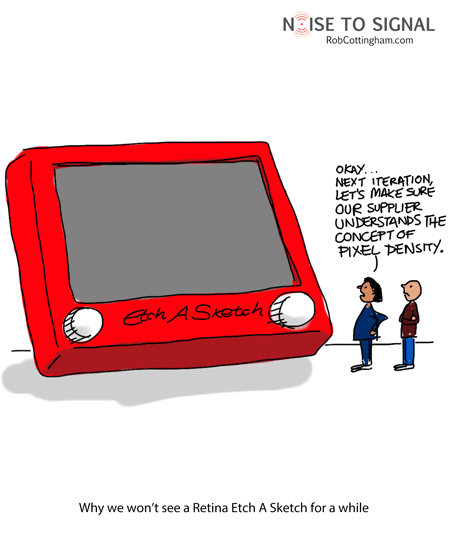Originally posted on ReadWriteWeb
The outrage a few weeks ago over the Etch A Sketch scandal (what to call it? “Shake-and-gate”?) was bad news for Republican front-runner Mitt Romney. But it was good news for one of my favorite toys of all time: Etch A Sketch is apparently having a big resurgence.
Which brings back some pretty fond memories. A lot of kids like me spent hours, hours leaning over their Etch A Sketches, twisting knobs with painstaking care, slowly creating images that would then vanish with a quick invert-and-shake. It was a lesson in impermanence and the virtue of nonattachment… and, at a less spiritual level, the ability to move your hands in one location to draw in another.
Thanks to those hours of Etch A Sketching, when the time came to operate a mouse for the first time, my brain wasn’t completely thrown. I not only recognized the separate location of movement and visual feedback, but welcomed it. And for a kid who’d managed to verrrrry carefully create the U.S.S. Enterprise with two knobs and a free Saturday afternoon, those first windowed interfaces held no terrors.
There may be some synchronicity at work in the timing of Etch A Sketch’s sudden surge in renown. It speaks to the 2-D image’s newfound status, whether it’s found in the explosive growth of Pinterest, the popularity of infographics, the increased emphasis on data visualization, the White House whiteboard (and Edward Tufte’s role as a White House advisor), or the growing prominence of visual practitioners like Dan Roam and Sunni Brown.
Communicating visually crosses boundaries of language and literacy; it conveys ideas quickly and memorably; and it creates social objects for resharing, pinning and posting. Of course, it’s also open to spectacular abuse; a little fiddling with colors, shapes or proportions, and you can create a highly persuasive but deeply misleading image.
All of this suggests to me that we might want to revisit our schools’ curricula. We place a lot of emphasis – rightly – on reading and writing skills, on how to construct a sentence and organize an outline and structure an essay. Visual communication doesn’t get nearly the same attention, which means we aren’t teaching kids (or adults) how to communicate effectively with images. And we definitely aren’t giving them the critical skills to know when an image is lying to them.
Visual communication is rapidly becoming crucial for anyone who wants to explain, persuade or inform… and that’s an awful lot of us. And we should be encouraging kids to develop the skills involved.
And until curricula make that leap, sitting down with them over an Etch A Sketch may not be a bad first step.

